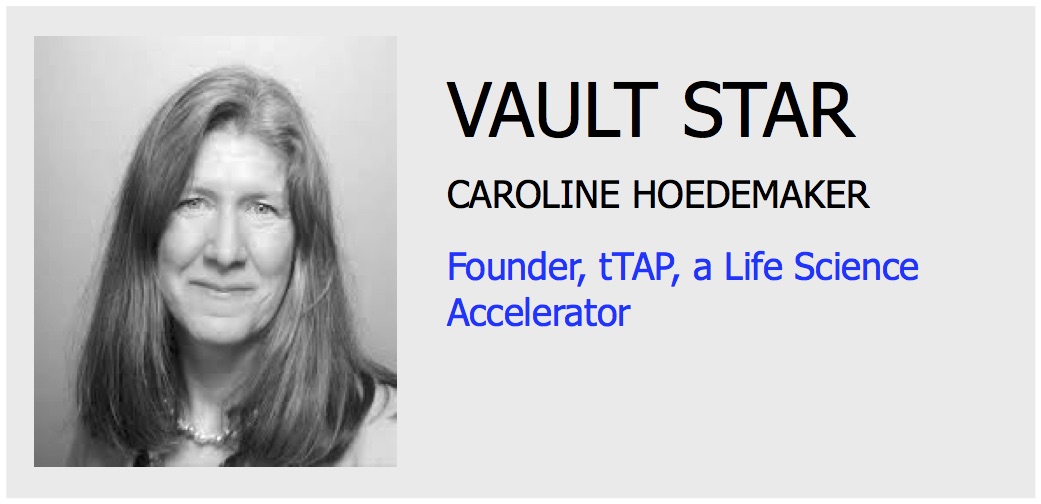How to Take a Life Science Company From Founding to Exit
25 July, 2020On September 28th 2017, ShareVault, along with tTAP, BIO (Biotechnology Innovation Organization) and WIB (Women in Bio), hosted a web panel discussion on how to successfully move a life science organization from founding to exit. During this discussion, experienced founders provided guidance on how executive teams can strike a balance between business development and the pursuit of science to overcome stumbling blocks and achieve successful outcomes.
 The web panel discussion was moderated by Caroline Hoedemaker, founder of tTAP, a Life Science Accelerator. Caroline was joined by Wendy Perrow, Chief Executive Officer of AsclepiX Therapeutics, Robert Alonso, founder and CEO of Mitochon Pharmaceuticals, and Richard Hughen, Chief Executive Officer of Cellth Systems.
The web panel discussion was moderated by Caroline Hoedemaker, founder of tTAP, a Life Science Accelerator. Caroline was joined by Wendy Perrow, Chief Executive Officer of AsclepiX Therapeutics, Robert Alonso, founder and CEO of Mitochon Pharmaceuticals, and Richard Hughen, Chief Executive Officer of Cellth Systems.
This web panel featured real stories from people who have hit the trenches from the entrepreneurial business CEO perspective and have run the gauntlet to an exit. Founders provided unique insight on when to bring on new talent and skill sets, when to engage partners, investors and board members and how to recognize the need to evolve as organizations change.
In a preview to the web panel discussion, we sat down with Caroline Hoedemaker to discuss some of the challenges that life science companies face as they make the journey from founding to exit.
Why did you found tTAP, a Life Science Accelerator?
 Medical life science companies face a lot of challenges, including navigating the balance between building a business and optimizing scientific progress, working with investors and entering into commercialization. Over the course of my career I’ve found that many organizations struggle with some or all of these challenges. The key to success in this business is building strong teams, forming strategic partnerships and sharing information. Too often life science organizations don’t realize that they are only part of the puzzle and their world needs to get larger; they need to figure out how to find the right people to aid in their success.
Medical life science companies face a lot of challenges, including navigating the balance between building a business and optimizing scientific progress, working with investors and entering into commercialization. Over the course of my career I’ve found that many organizations struggle with some or all of these challenges. The key to success in this business is building strong teams, forming strategic partnerships and sharing information. Too often life science organizations don’t realize that they are only part of the puzzle and their world needs to get larger; they need to figure out how to find the right people to aid in their success.
That’s what tTAP is all about. We help organizations build their businesses by focusing on the right strategy, building effective teams and getting funding.
When you have good teams with good funding and good science, that’s when you see products that successfully make it to customers. I’m passionate about helping companies do that.
How does your buy-side M&A experience at Johnson & Johnson help you work with sell-side companies at your accelerator? What is your advise to sell-side companies?
My buy-side experience at Johnson & Johnson was incredibly valuable. I screened hundreds of companies and had the opportunity to interact with experts across the whole spectrum of research through product development and into sales. So, I have that perspective; I know what buy-side companies are looking for. Now, when I’m working with life science companies and evaluating what is going to make them attractive to partners or large pharma, I can pull from my experience at Johnson & Johnson.

Just recently, I was helping a scientist with a grant application, and it was clear to me that he struggled to elevate his differentiators when comparing himself to the competition. That was an immediate red flag for me. When we talked informally, he was very capable of reciting a litany of his product’s unique features, but when he showed me his differentiation slide the passion and the details on how he was better weren’t there. If I were someone considering a purchase of his technology, I wouldn’t have taken a second look. You need to find your differentiator, and be sure its value is clearly presented if you want to get a buy-side organization like Johnson & Johnson to look at you and value you.
What is the optimal balance of science and business for a successful start up?
That really depends on the company, the industry type and the development stage the company is in. Right now I have a client whose company needs to be 90% focused on the science. When you’re young, it’s the science that matters. At the end of the day, if you don’t have good science, you’re not that interesting.
At the same time, the science side of the organization needs to be listening to what the business side has to say. The company may be 90% focused on the science and only 10% focused on business development, but science founders should develop good partners early and listen to the business side to ensure 1) their product fills a fundable need and 2) they are structured such that they can get the funding to move forward.
Further along the development path, as you move into later stage drug, diagnostic or device development work, the balance begins to shift. That’s when it becomes critical to involve a mix of expertise, and have a strong business or finance partner to ensure that you can communicate the product’s and business’ benefits. It is valuable to have a long term relationship with one of these partners as you grow. The deeper you get into the product lifecycle, the more emphasis there will be on the business side of things.
What is the most important element executive teams founding new companies should focus on?

That is a really challenging question. If the science isn’t there, the product won’t help patients in the end, but if the team isn’t on board, it is much harder to get funding. If you don’t have a good team then you likely won’t realize the investments you need to move forward. I have seen VC’s fund teams with sketchy science, but rarely the later. The further the science advances, and the larger the size of the funding required, the more important the team and the business side becomes. I’ve heard a VC say that before evaluating a company’s technology, they evaluate the company’s team.
If you build a good team from the start, then you’ll likely get funding. The funding fuels good science and the commercialization of that science. It’s all important, but it all starts with a good team.
What should organizations think about when seeking funding?
There are different types of funders with different perspectives, different interests, different size wallets, and different perceptions on risk, which can result in different outcomes for the company seeking funding.
Consider a therapeutics opportunity that has the potential to have early revenue in a discovery market. While some investors like to see the potential for early revenue, there’s also an associated expense to make that happen. You have to decide if you want all of your funding to go to marketing and sales to ensure early on success in that revenue model, or if you’d rather the funding go to the development of the drug, so that it’s a multi-billion dollar drug further down the road. Different investors will want to play in different spaces, so it’s important to reach out to the right investment firm based on your long-term strategy.
To learn more about the many challenges and opportunities life science companies face when transitioning from founding to exit: request a recording of the web panel discussion.
